Picture this: as a bride, you’re holding not just a bouquet of flowers, but a treasure trove of emotions and history.
From the timeless cascade bouquets of yesteryears to the contemporary hand-tied wonders of today, each bloom speaks volumes about love and legacy.
Clasping your bouquet close, you can feel a surge of pride knowing you’re carrying forward a tradition steeped in beauty and meaning.
It’s not just about the flowers; it’s about weaving together the threads of love, memories, and time-honored customs that make weddings truly enchanting.
With every step, your bouquet becomes a beacon of romance. It guides you down the aisle toward a future brimming with promise. In its delicate petals, the essence of generations past and the promise of a lifetime of love to come lie.
Now, let’s explore more about the special traditions of wedding flowers and learn more about beautiful bouquets.
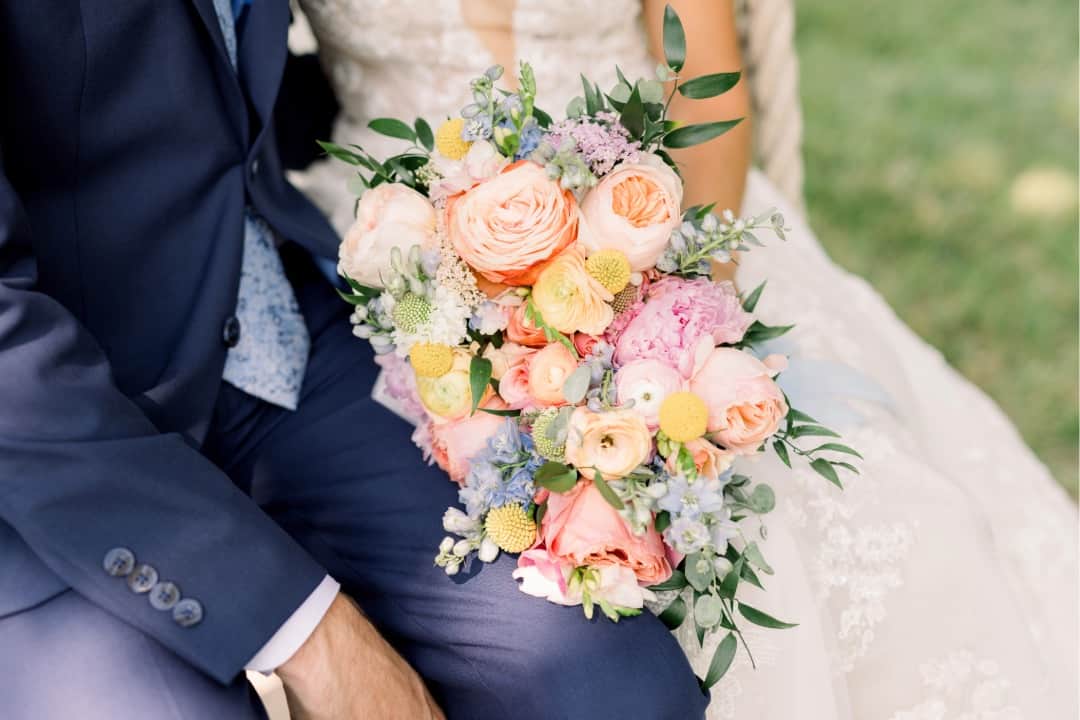
Key Takeaway
- Bridal bouquets have a rich history and have evolved over time, reflecting cultural traditions and personal preferences.
- Flowers play a crucial role in wedding ceremonies, serving as symbols of love, beauty, and new beginnings.
- The bouquet toss is a beloved wedding tradition that has been adapted to suit modern couples and their guests.
- Incorporating wedding flower traditions today involves blending personal style with cultural customs to create meaningful and unique floral arrangements.
The Evolution of Bridal Bouquets
The evolution of bridal bouquets is a fascinating journey through time, reflecting cultural shifts and symbolism. Initially, bouquets consisted of simple herbs and flowers chosen for their practicality and symbolism.
Over time, the significance of flowers deepened. Each bloom carries a meaning that a bride carefully selects for their bouquets, weaving a story of love and meaning into their wedding days.
Let’s not forget the wedding bouquet toss, one of the most common wedding traditions. This playful custom symbolizes good luck and the passing of happiness.
And we can trace that from ancient times to modern weddings.
Bridal Bouquets Through Different Eras
Bridal bouquets have evolved significantly throughout history, reflecting cultural, social, and fashion changes.
Ancient Times
In ancient Egypt, Greece, and Rome, brides carried herbs, spices, garlic, and grains to keep away bad spirits and ensure they could have children. They also used flowers with special meanings.
For example, in ancient Greece, brides held bouquets of ivy for loyalty and roses for love.
Medieval and Renaissance Periods
In the Middle Ages, brides still carried herbs and flowers, often in wreaths on their heads. Roses, lilies, and daisies were popular.
Wedding bouquets were small and simple because that’s how things were then.
Victorian Era
In Victorian times, people became interested in flowers and their meanings again. Brides had fancy bouquets called “tussie-mussies,” small bunches of flowers and herbs wrapped in lace or ribbons. Each flower meant something, like roses for love and lilies for purity.
Edwardian Era
In the early 1900s, bouquets became bigger and fancier. Brides carried cascading bouquets with lots of flowers, like orchids, lilies, and roses, arranged in a romantic style.
Mid-20th Century
By the mid-1900s, bouquets got more structured and formal. Round bouquets with roses or lilies were popular, and they were smaller than in the Edwardian era, showing a shift towards simplicity.
Contemporary Trends in Bridal Bouquets
Meanwhile, modern bridal bouquets are diverse and reflect individual tastes and preferences. You may choose from various flowers, colors, and styles to suit your wedding theme and personal style.
Some popular bouquet styles include hand-tied, cascading, and posy bouquets. Meanwhile, roses, peonies, hydrangeas, and ranunculus remain popular flowers.
However, some brides incorporate unconventional elements like succulents, feathers, and brooches into their bouquets.
Throughout history, bridal bouquets have served as symbols of love, purity, and fertility, reflecting the values and customs of each era. While styles may change, carrying a bouquet down the aisle remains a timeless and cherished part of the wedding ceremony.
Role of Flowers in Wedding Ceremonies
Flowers play a significant role in wedding ceremonies across cultures and have various symbolic meanings. When considering floral arrangements, it’s important to ask, “How much do wedding flowers cost?” Understanding this helps with budgeting and ensuring the chosen blooms align with both the wedding theme and financial plan..
1. Flowers in the Wedding Ceremony
Floral ornaments add beauty, fragrance, and symbolism to the ceremony. They adorn the ceremony venue, including the altar, pews, or chairs, and are often incorporated into floral arrangements, arches, and aisle decorations.
Most importantly, they help create a romantic and celebratory atmosphere, enhancing the ambiance of the ceremony.
2. The Bride’s Bouquet
Besides the bride and her wedding dress, the bouquet is one of the focal points of the wedding ceremony. That’s no wonder, as it symbolizes beauty, fertility, and new beginnings.
The bride traditionally carries her bouquet as she walks down the aisle. This bridal bouquet expresses her style and personality, especially when coordinated with the bridal attire and wedding theme.
3. Flower Girls and Their Traditions
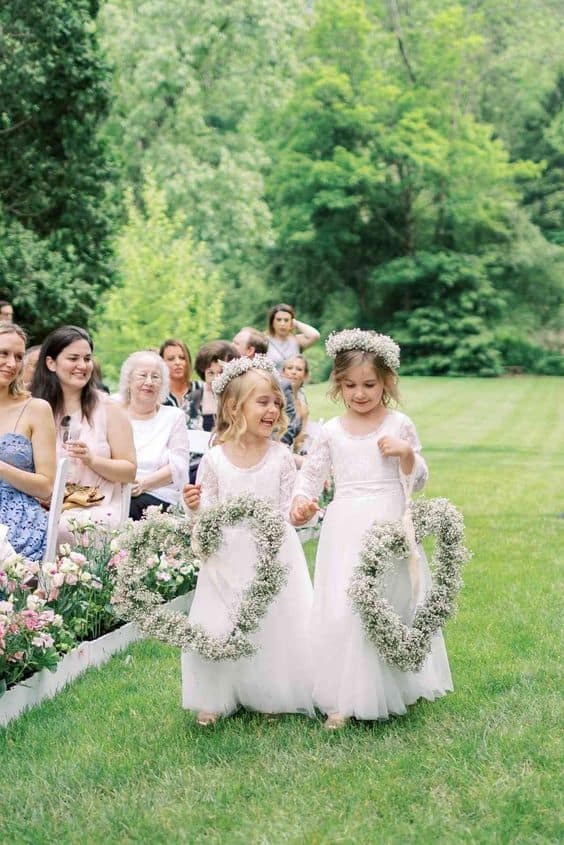
Credits: @brides /Pinterest
Generally, a flower girl precedes the bride as she walks down the aisle with her bouquet. This young girl showers the bride with flower petals – for fertility and good luck.
In some cultures, flower girls carry small bouquets, baskets, or pomanders filled with flowers instead of scattering petals.
And their importance? They add an element of innocence and charm to the ceremony since they’re usually dressed in attire similar to the bride or bridesmaids.
4. Floral Garlands in Wedding Rituals
Floral garlands worn in wedding rituals in different countries worldwide are also known as flower crowns or lei.
In Hindu weddings, the bride and groom exchange floral garlands, called “varmala,” as a symbol of acceptance and mutual respect.
Meanwhile, couples in Hawaiian weddings exchange lei made from fragrant flowers as a gesture of love and aloha spirit. Moreover, floral garlands symbolize unity, love, and the eternal bond between the couple.
Overall, flowers play a multifaceted role in wedding ceremonies. They represent love, beauty, purity, and the beginning of a new life together. They add a natural elegance to the celebration and help create cherished memories that last a lifetime.
Understanding Bouquet Toss Tradition
The bouquet toss tradition is a fun and often lighthearted ritual commonly performed at weddings.
It’s a symbolic gesture that brings luck and fortune to the unmarried women who catch the bouquet. And the woman who catches the bouquet is believed to be the next to get married.
Thus, the tradition adds an element of excitement and anticipation to the wedding reception, especially since it allows single guests to participate in the festivities.
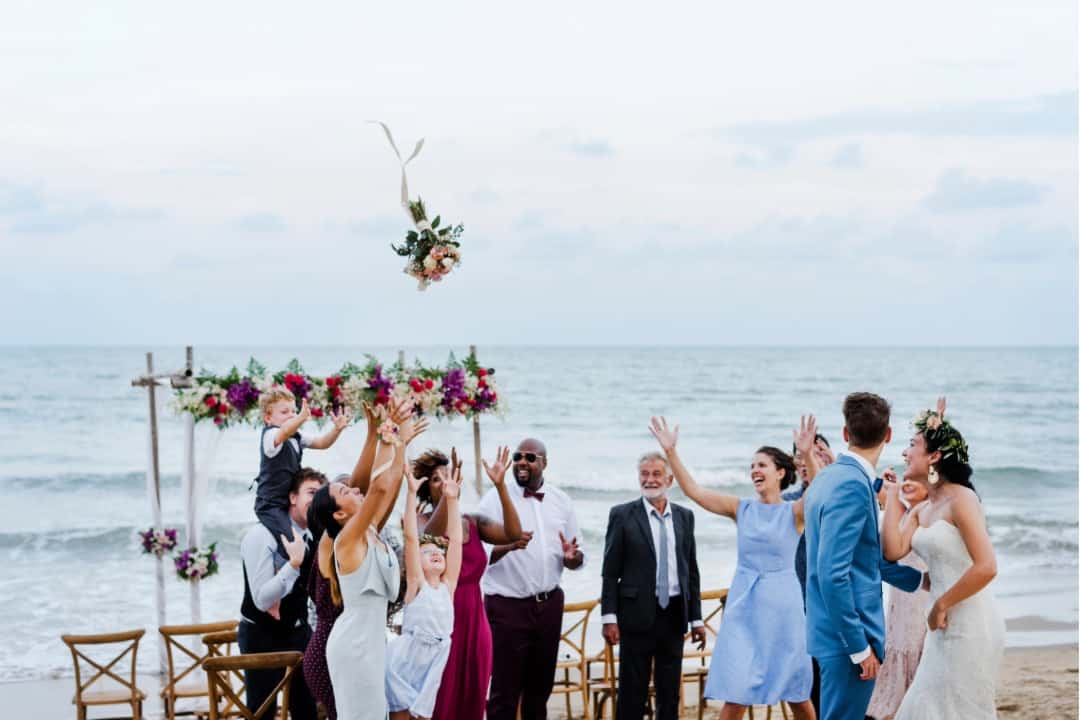
History and Development of the Tradition
The bouquet toss tradition’s origins are a bit unclear, but it’s thought to have started in medieval Europe. Brides used to toss personal items like gloves or garters to guests to share their happiness. Eventually, this evolved into the bouquet toss, where the bride throws her bouquet to unmarried female guests.
Modern Takes and Changes
While the basic idea of the bouquet toss stays the same, modern couples often customize it to make it more memorable or fun. Some variations include:
- All guests, no matter their relationship status or gender, can join in.
- Letting the person who catches the bouquet make a wish.
- Giving a piece of advice to the bride before tossing.
- Adding props or music to make it more exciting.
- Choosing different items to toss, like an artificial bouquet or a small gift basket.
However, some couples decide not to do the bouquet toss at all. They might have reasons, like wanting to make single guests feel more comfortable. Instead, they devise other activities or games to entertain everyone.
The bouquet toss tradition brings a playful and joyful vibe to wedding parties, symbolizing hope for the future. Although its popularity has changed over time, reflecting shifts in how people view marriage and relationships, it’s still a beloved part of many weddings.
Flower Symbolism Across Cultures
Besides beautification, flowers hold significant cultural symbolism, often representing various emotions, beliefs, and traditions.
- Japan: Cherry blossoms (sakura) symbolize life’s transient nature and impermanence’s beauty. In addition to their national flower, chrysanthemums represent longevity and happiness.
- India: Marigolds are special in Indian culture, often used in religious ceremonies and festivals. In addition, lotus flowers symbolize purity and enlightenment in Hinduism and Buddhism.
- China: Peonies are highly regarded in Chinese culture. They symbolize prosperity, honor, and wealth. Chinese also regard orchids as representing refinement and friendship.
- Middle East: Middle Eastern cultures’ symbolism of roses includes love, beauty, and passion, while jasmine is associated with purity and grace.
- Europe: Like the Middle East, Europe associates roses with love and romance in European cultures. Also, lilies symbolize purity and innocence, while sunflowers symbolize loyalty and adoration in this continent.
Superstitions and Beliefs Surrounding Wedding Flowers
Although flowers have a positive connotation, they are also associated with superstitious beliefs, especially regarding wedding flowers. These beliefs are prevalent across various cultures and often stem from folklore, mythology, and historical traditions.
Some believe certain flowers bring good luck, while others may bring misfortune. For example, using red roses in a wedding bouquet is considered unlucky because they symbolize blood and can bring bad luck to the marriage.
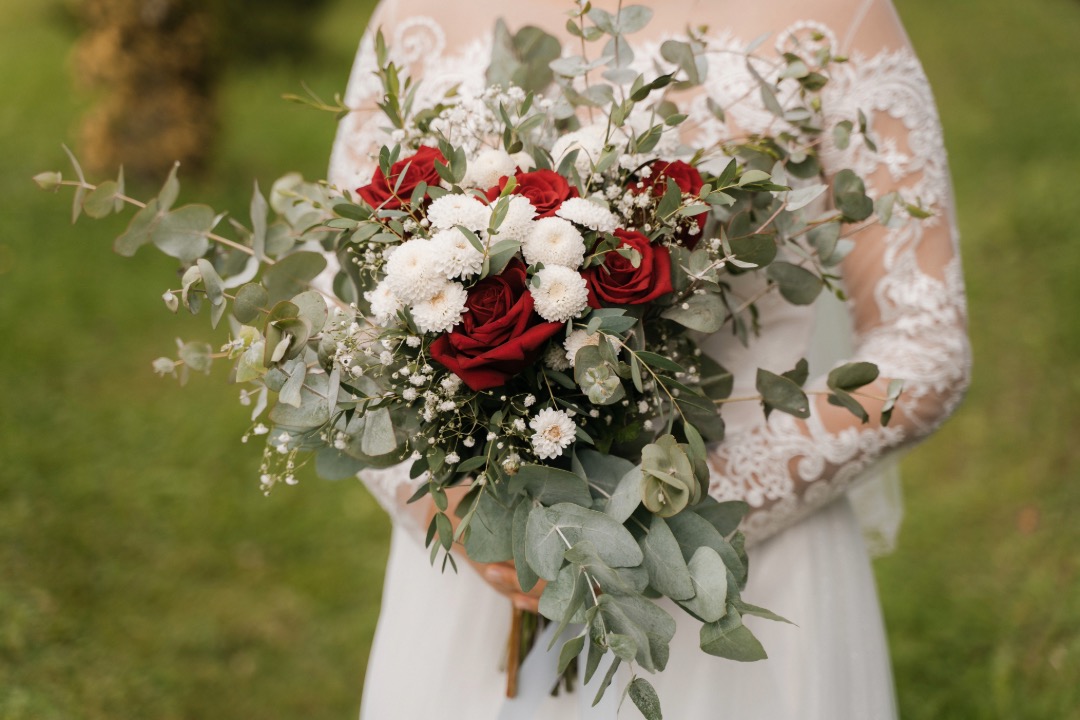
Another wives’ tale concerns dropping the bridal bouquet during the ceremony. It’s said that doing this is an omen of bad luck for the marriage. Brides carry flowers with care to counteract this, while some intentionally toss the bouquet at the end of the ceremony to avoid accidentally dropping it.
And if flowers wilt or die before the wedding day, it’s often interpreted as a sign of impending misfortune or a doomed marriage.
The choice of flower colors can also carry significance. In some cultures, specific colors are associated with death or mourning and are therefore avoided in wedding floral arrangements.
The most classic ones are roses. They’re often associated with love and passion due to their connections with Greek mythology, where they were sacred to the goddess of love, Aphrodite.
Dispelling Myths: Understanding the Truth
Many superstitions surrounding wedding flowers have historical origins that may not necessarily hold today.
While some people may adhere to certain superstitions out of tradition or cultural beliefs, others may disregard them entirely. Ultimately, the significance of wedding flowers is subjective and varies from person to person.
But instead of dwelling on superstitions and beliefs, why not focus on the joyous celebration of your love and the meaningful symbolism of your chosen flowers?
Popular Flowers and Their Meanings in Weddings
When it comes to wedding flowers, each bloom carries its own special message. Here are some popular choices and what they symbolize:
- Roses: Known for their timeless beauty, roses are all about love and romance. Different colors have different meanings:
-
- Red roses: Deep love and passion, perfect for a romantic wedding.
- White roses: Purity and new beginnings, often seen in bridal bouquets.
- Pink roses: Admiration and gratitude, adding a touch of joy to the occasion.
- Lilies: Elegant and sophisticated, lilies symbolize purity and innocence. They’re a classic choice for bouquets and decorations, adding a timeless charm to your ceremony.
- Orchids: Exotic and luxurious, orchids represent love, beauty, and elegance. Their variety of colors and shapes brings a touch of refinement and sophistication to any wedding setting.
These are just a few examples of popular wedding flowers and their meanings. Couples often choose flowers based on what resonates with them and their wedding style. The key is to create a unique and meaningful floral experience for your special day.
Tips for Incorporating Wedding Flower Traditions Today
When it comes to weddings, flowers play a big part in honoring traditions while showcasing your style. Here’s how to blend tradition with your unique touch:
- Learn Your Roots: Discover the floral customs of your culture or background and decide which ones you want to include in your wedding.
- Give Tradition a Twist: Put a modern spin on old customs. Mix in trendy arrangements, colors, and designs to make them your own.
- Embrace Diversity: If you and your partner have different backgrounds, blend elements from both traditions for a meaningful fusion.
- Stay True to You: Pick flowers that match your style and wedding theme, whether it’s classic, bohemian, or minimalistic.
- Add Personal Flair: To make your decor uniquely yours, include heirlooms, family flowers, or sentimental items.
- Pick Meaningful Colors: Choose flowers in colors that are special to you both, like your grandmother’s favorite or a bloom from a cherished memory.
- Team Up with Your Florist: Work closely with your florist to share your vision and preferences. Inspire and reference images to ensure everything aligns with your dream.
- Cherish Special Blooms: Incorporate flowers that hold sentimental value, like the ones from your first date or those that symbolize precious moments in your relationship.
- Honor Your Heritage: Integrate cultural symbols or traditional arrangements to pay homage to your roots.
Combining tradition with your personal touch will make your wedding flowers a beautiful reflection of your love story.
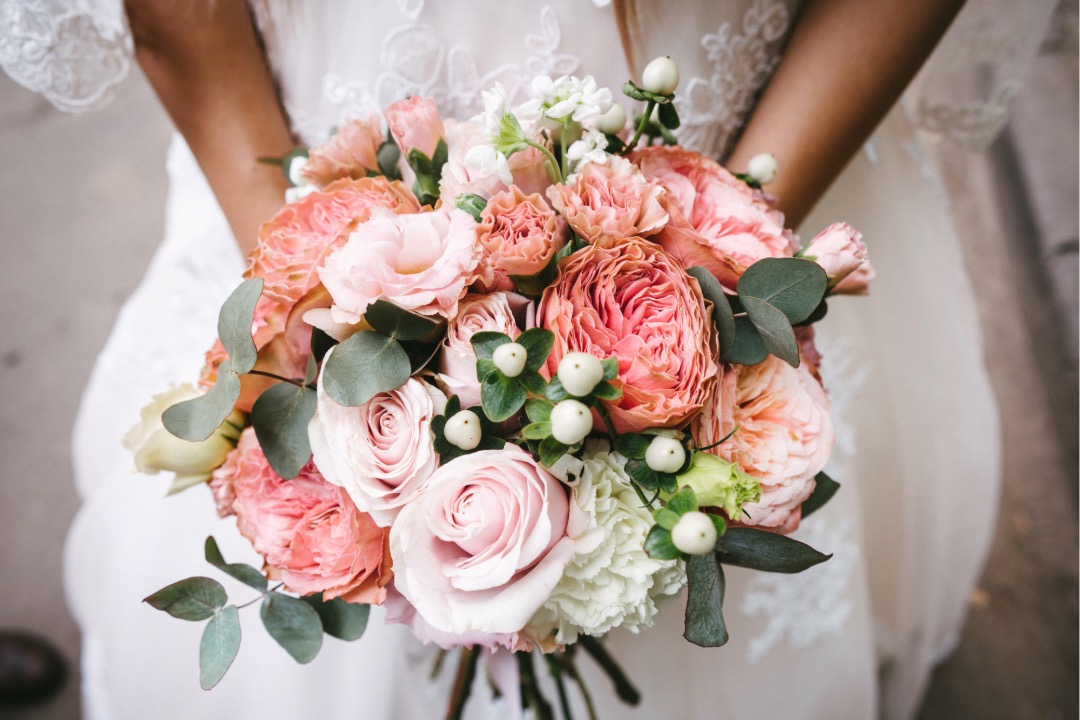
Conclusion
In closing, let’s appreciate the beauty and meaning of these timeless traditions. Each flower petal holds a story, showing us how powerful symbols and emotions can be.
From the lovely scent of roses to the elegance of lilies, every flower carries the wishes and dreams of the bride and groom. By embracing these meanings, you embark on a journey of love and unity.
As you fill your wedding venue with colorful blossoms and sweet fragrances, you create an atmosphere of romance and happiness.
So, whether you stick to tradition or add a modern twist, remember that each flower represents your enduring love and commitment.